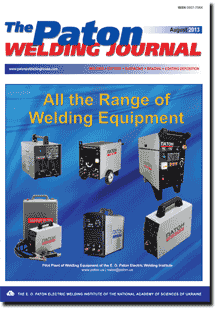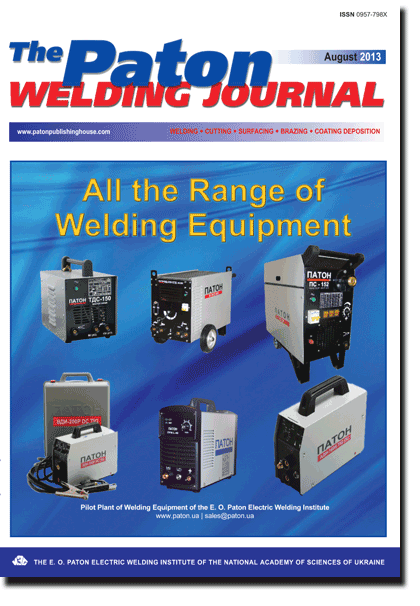| 2013 №08 (02) | 2013 №08 (04) |

The Paton Welding Journal, 2013, #8, 13-24 pages
INFLUENCE OF TECHNOLOGICAL FACTORS IN MANUFACTURE OF LOW-HYDROGEN ELECTRODES ON HYDROGEN CONTENT IN THE DEPOSITED METAL
A.E. MARCHENKO and N.V. SKORINA
E.O. Paton Electric Welding Institute, NASU. 11 Bozhenko Str., 03680, Kiev, Ukraine. E-mail: office@paton.kiev.ua
Abstract
PWI department of «Physico-chemical processes in the welding arc», led by Prof. I.K. Pokhodnya, academician of NASU, celebrated its 50th anniversary in 2012. Alongside the work on arc welding metallurgy and development of welding consumables, a considerable scope of research conducted by the department staff during this period deals with improvement of the technology of mechanized production of welding electrodes. This work enables clarifying the nature of the phenomena which are the basis for technological processes of manufacturing this kind of mass products, as well as improving the metallurgical, technological and service characteristics of electrodes and their quality. Given below are the results of investigation of the influence of such technological factors of manufacturing low-hydrogen electrodes as composition and amount of water glass in the electrode compound, its interaction with marble in the electrode coating, as well as organic hydrocolloids (carboxylmethyl cellulose and alginates) on dehydration of electrode coating and hydrogen content in the deposited metal. It is found that alkali hydrosilicates remaining in the electrode coating after dehydration of its water glass binder during electrode heat treatment, are a potential source of hydrogen in the deposited metal. There exists a direct relationship between water-retaining capacity of sodium-potassium hydrosilicates, dependent on the module and Na2O:Ka2O ratio, potential hydrogen content in the coating and hydrogen content in the deposited metal. However, at evaluation of the degree of potential hydrogen «assimilation» by the deposited metal, we should take into account the possible influence of potassium and sodium ions contained in the hydrosilicate, on fluorine removal from the reaction of hydrogen fluoride formation and on kinetic conditions of hydrogen sorption and desorption by electrode metal drop. Marble powder, contained in the electrode coating, and water glass which is the coating binder, interact with each other in a heterophase fashion. Calcium ions coming to the water glass binder lower the water-retaining capasity of alkali hydrosilicates. Products of interaction on marble particle surface hinder their thermal dissociation up to higher temperatures, compared to the temperature of pure calcite dissociation. Both promote lowering of hydrogen content in the deposited metal. Organic hydrocolloids such as sodium modifications of carboxylmethyl cellulose (CMC) and sodium or potassium alginates, are sorbed by the surface of marble particles and, blocking water glass access to it, they hinder the heterophase transition of calcium ions into the water glass. This has a favourable effect on the technological properties of electrode compounds, but at the same time improves the water-retaining capacity of alkali hydrosilicates in the electrode coating and hydrogen content in the deposited metal. Calcium ions are capable of moving from calcium-containing CMC modifications and alginates into the water glass binder as they do from calcite particle surface. Therefore, they should be considered as technological additives, which not only increase the plasticity of electrode compounds, but also lower the potential hydrogen content in the coating and hydrogen content in the deposited metal. 15 Ref., 8 Tables, 7 Figures.
Keywords: manual arc welding, welding electrodes, electrode coating, water glass, hydrogen in the deposited metal, cold cracks, technological causes for hydrogen lowering
Received: 29.04.13
Published: 28.08.13
References
1. Horowitz, H.H., Metzger, G.A. (1963) New analyzes of thermogravimetric traces. Anal. Chem., 35(10), 1464-1468.
2. Marchenko, A.E., Skorina, N.V., Suprun, S.A. (1987) Water-retaining capacity of alkali silicates and its effect on electrode coating degradation. In: Inform. documents of CMEA. Kiev: Naukova Dumka, Issue 1.
3. Pokhodnya, I.K., Marchenko, A.E., Koritsky, G.G. Compound for coating of welding electrodes. USSR author`s cert. 288961. Int. Cl. B 23 k, 35/36. Fil. 12.09.69. Publ. 08.11.70.
4. Pokhodnya, I.K., Yavdoshchin, I.R., Yurlov, B.V. (1981) Influence of some technological factors on diffusion hydrogen content in welds made with basic electrodes. Avtomatich. Svarka, 1, 31-33.
5. Matveev, M.A., Rabukhin, A.I. (1961) Relation between water solution density of alkali silicates and their composition. Steklo i Keramika, 6, 21-26.
6. Lakomsky, V.I. (1998) About macrokinetics of process of interaction between nitrogen from electric arc plasma and molten metal. Problemy Spets. Elektrometallurgii, 1, 56-65.
7. Petran, K.V. (1951) Manufacturing of UONI-13, UP-1 and UP-2 electrodes in powerful presses under high pressure. Avtogen. Delo, 8, 31-33.
8. Korneev, V.I., Danilov, V.V. (1996) Water and soluble glass. St.-Petersburg: Strojizdat.
9. Uvarova, I.Yu., Lukyanova, O.I. (1996) Examination of induction period of solidification in interaction of Na and Ka silicates in concentrated suspensions. In: Physicochemical mechanics of dispersion structures. Moscow: Nauka.
10. Lavrenov, L.V., Marchenko, A.E., Shkurko, S.A. (1975) Peculiarities of alkali silicate adsorption from water glass by marble and fluorite in electrode coatings. Avtomatich. Svarka, 3, 34-38.
11. Dushina, A.P., Aleskovsky, V.B. (1963) Silica gelЕ inorganic cationite. Moscow: Strojizdat.
12. Burns, J.H., Bredig, M.A. (1956) Transformation of calcite to aragonite by grinding. J. Chem. Phys., 25(6), 1281.
13. Marchenko, A.E., Skorina, N.V., Voroshilo, V.S. et al. (1979) About some technological problems caused by interphase processes in manufacturing of welding electrodes. In: Inform. materials of CMEA. Kiev: Naukova Dumka, Issue 1.
14. Katler, A.I. (1965) Kinetics of thermal decomposition of some minerals. In: Kinetics of high temperature processes. Ed. by V.D. Kindzheri. Moscow: Strojizdat.
15. Chen, B., Han, F., Huang, Y. et al. (2009) Influence of nanoscale marble (calcium carbonate CaCO3) on properties of D600D surfacing electrodes. Welding J., 88(5), 99-103.
Suggested Citation
A.E. MARCHENKO and N.V. SKORINA (2013) INFLUENCE OF TECHNOLOGICAL FACTORS IN MANUFACTURE OF LOW-HYDROGEN ELECTRODES ON HYDROGEN CONTENT IN THE DEPOSITED METAL. The Paton Welding J., 08, 13-24.The cost of subscription/purchase order journals or individual articles
| Journal/Currency | Annual Set | 1 issue printed |
1 issue |
one article |
| TPWJ/USD | 384 $ | 32 $ | 26 $ | 13 $ |
| TPWJ/EUR | 348 € | 29 € | 24 € | 12 € |
| TPWJ/UAH | 7200 UAH | 600 UAH | 600 UAH | 280 UAH |
| AS/UAH | 1800 UAH | 300 UAH | 300 UAH | 150 UAH |
| AS/USD | 192 $ | 32 $ | 26 $ | 13 $ |
| AS/EUR | 180 € | 30 € | 25 € | 12 € |
| SEM/UAH | 1200 UAH | 300 UAH | 300 UAH | 150 UAH |
| SEM/USD | 128 $ | 32 $ | 26 $ | 13 $ |
| SEM/EUR | 120 € | 30 € | 25 € | 12 € |
| TDNK/UAH | 1200 UAH | 300 UAH | 300 UAH | 150 UAH |
| TDNK/USD | 128 $ | 32 $ | 26 $ | 13 $ |
| TDNK/EUR | 120 € | 30 € | 25 € | 15 € |
AS = «Automatic Welding» - 6 issues per year;
TPWJ = «PATON WELDING JOURNAL» - 12 issues per year;
SEM = «Electrometallurgy Today» - 4 issues per year;
TDNK = «Technical Diagnostics and Non-Destructive Testing» - 4 issues per year.


